“From a very young age, I just fell in love with the river,” Cliff Reid tells me. “I’m 42 now and I’ve spent over 25 years on the river. I still can’t go over a bridge without stopping and looking down into the water.”
We meet Cliff on a hot, sunny morning in Carlow Town Park, on the River Barrow jetty.
Behind him floats the traditional Irish open boat in which he conducts his business, boattrips.ie. Cliff’s approach to providing a safe space to explore and learn about Ireland’s river systems has been a key aspect of his business’s success.
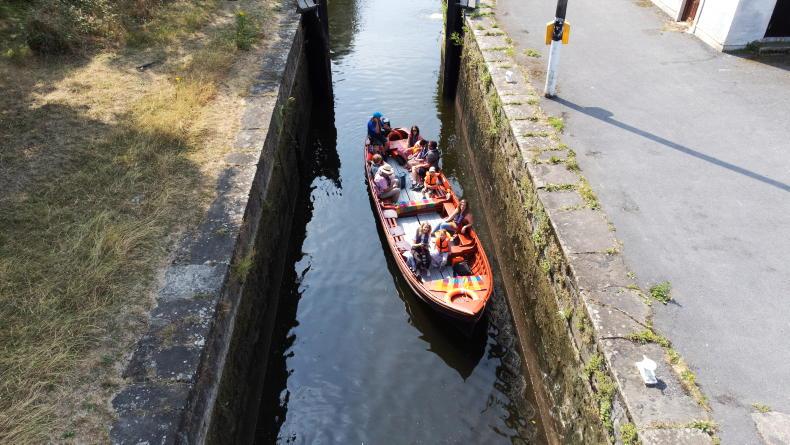
The boat enters the lock near the jetty in Carlow Town Park. \ Claire Nash
Operating out of Carlow, Kilkenny, Laois and Kildare, Cliff offers private river tours for small groups and families. These range from 30 to 80 minutes in length (prices range from €50-100) and incorporate not just the surrounding natural beauty, but the history of Ireland’s inland waterways and their close connection to agriculture and industry.
Born and raised on The Barrow
Irish Country Living asks Cliff what sparked such an interest in rivers to enable him to create an entire career.
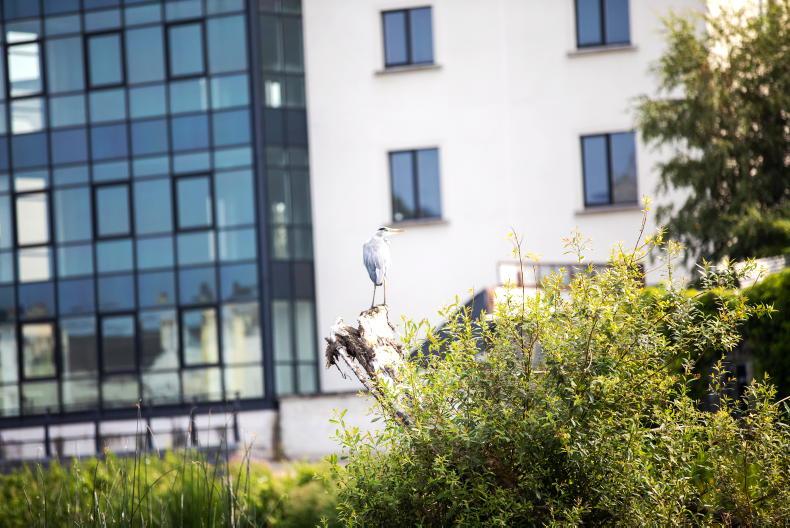
We spotted a heron (on the tree) during our trip, as well as a kingfisher. \ Claire Nash
“I was born and raised in Athy, and my house was 100m from the River Barrow,” he explains. “I was swimming, fishing and boating from a very young age. I bought my first boat when I was 16 – I saved up for two years to buy that boat. I spent that summer, then, just working on the boat and being on the water.
“I started fishing,” he continues. “Any day I had off was spent fishing on the river. Then, at 17 or so, I started kayaking – that opened up the river from a different perspective, for me. Lord’s Island (in the Barrow) was like my playground. Any weekend was spent fishing from that island or camping out.
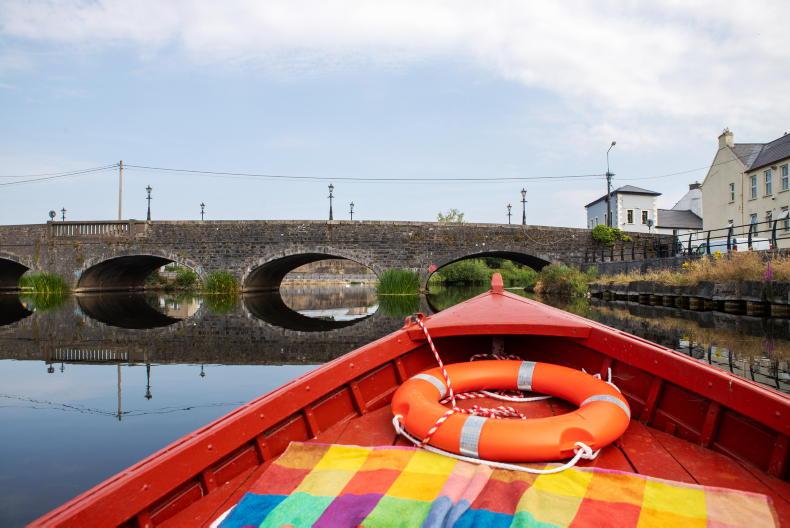
The boat is safe and comfortable; Cliff is prepared for most types of weather. \ Claire Nash
“We’d go down on the weekend, fish, eat whatever we caught – that was the kind of childhood I had. The island itself was formed by the canal (on one side) and the River Barrow (on the other). It had its own little forest and wildlife: otters, kingfishers, mallard ducks, sandpipers.”
Learning as you go
As Cliff found his feet (so to say) in his kayak and on the river, he says he also learned a lot from older people within the locality. The stories and wildlife knowledge he picked up from these people ultimately helped develop his business.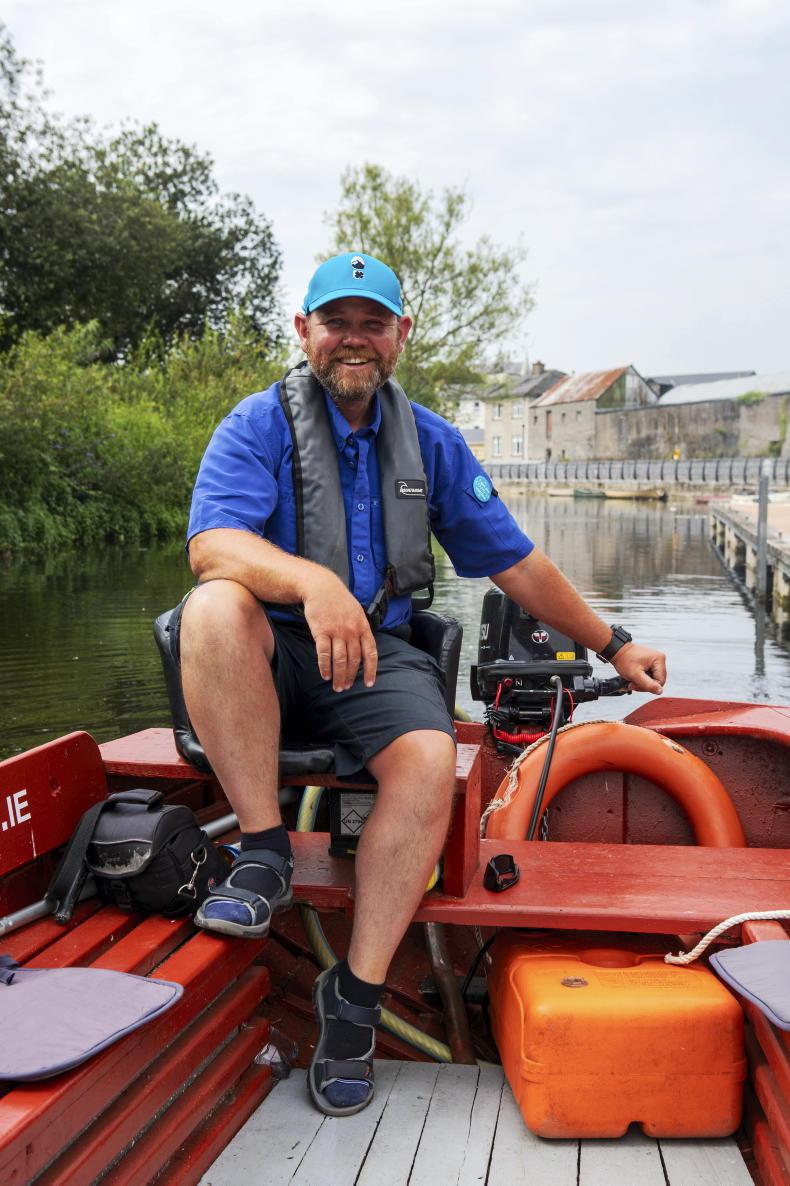
“You’d meet characters on the river and people would tell you stories – I love listening to the old folk on the river,” he smiles. “You’d go off with fishermen – I spent a lot of time fishing down in Carlow with my uncle. You’d learn stuff as you went along, and, on top of that, you’d learn from books. At an early age, I had an interest in birds. Each time you’re out on the river, you’d pick up different bits about nature and – then – when you have an interest you kind of start seeing it everywhere.”
Building a business
Building a business can be a slow and, for some, laborious process. For Cliff, it happened organically and is a testament to what can happen if you let your passions lead the way. He was originally working with the Ploughing Championships (he still helps out as needed), and taking visitors on kayaking tours of the Barrow. He eventually took the plunge (pun intended) and launched boattrips.ie in 2018.
At that time, they had one boat and the draw was mainly to international tourists travelling along the Ireland’s Ancient East trail. This business model worked well, so Cliff bought a second boat and moved into Kilkenny. They now have four boats which service the four counties where they provide tours.
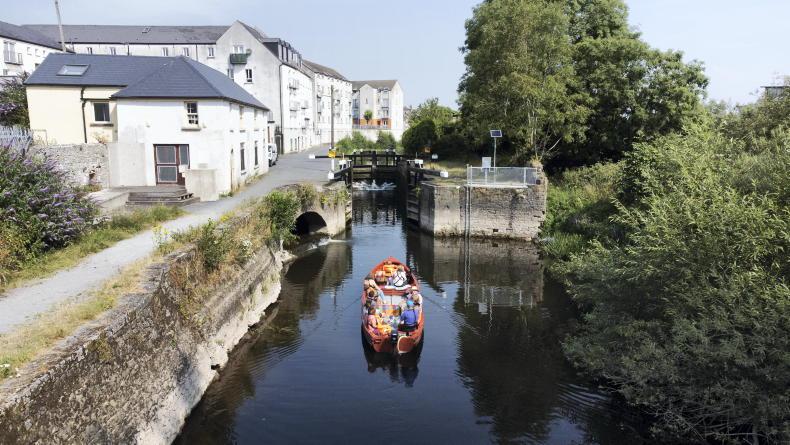
Approaching the lock in Carlow town. \ Claire Nash
“When people come, we aim to provide them with three basic things,” he says. “First and foremost, we want them to be safe, but we also want people to have fun and enjoy themselves. Third, we hope people can go away having learned a little – whether about the wildlife or the history of the area.”
Nature
“It’s a really good day if you see a kingfisher and, sometimes, you’ll see otters,” Cliff addresses the boat as we slowly make our way down the Barrow. “Oh, look! There’s a heron.”
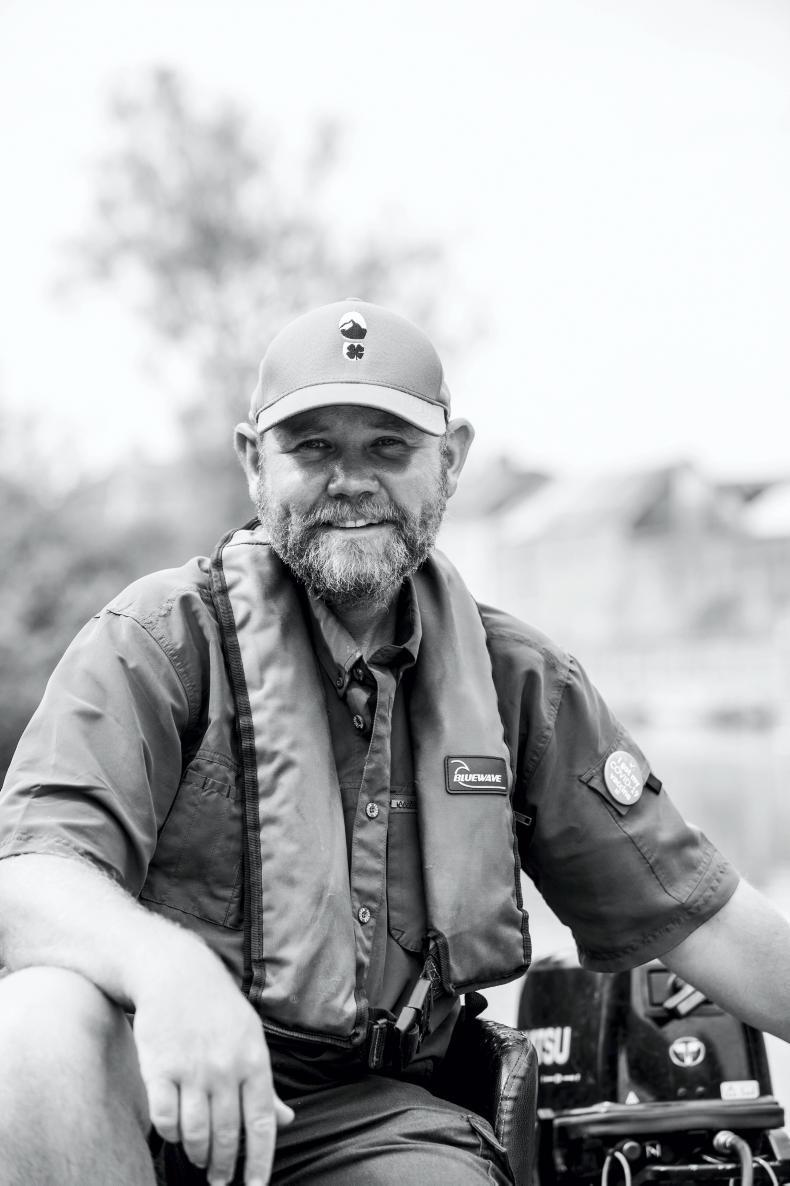
While we amble along, we are conversing with our boatmates: a staycationing family. They are farmers and live nearby, but have never done one of Cliff’s river tours. Their children are excited, as is my own daughter, and Cliff gives them each a chance to “drive the boat”, in turn.
But first, we take a few minutes to appreciate the nature around us – the heron; the many dragonflies skimming the surface. At times, you can see fish darting around in the water and – lo and behold; there it is: the iconic kingfisher. Our trip had been made (unfortunately, he was too quick for our photographer to capture).
“It’s something I notice – when you bring kids out the first thing they do is put their hands in the water – adults don’t do this,” Cliff points out. “We lose our connection with the water as we get older. Years ago, the rivers were the highways of Ireland – that’s where all the towns were established. Access to food and water, a way of getting rid of waste and a mode of transport – the connection people had with rivers [then] was massive.
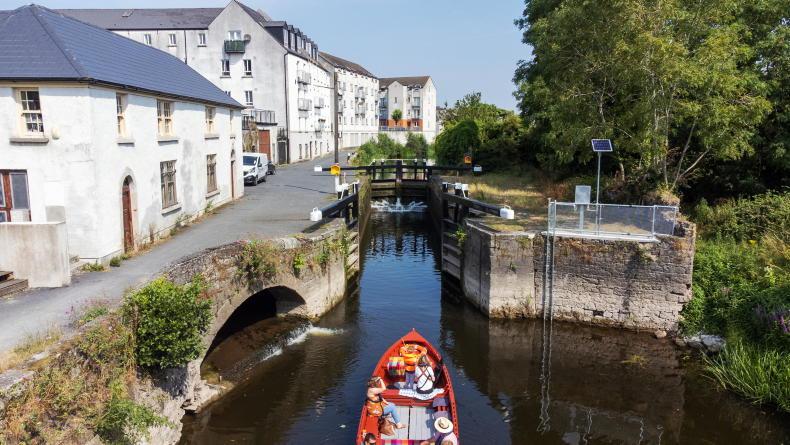
The boat approaches the lock in Carlow town. \ Claire Nash
“Everyone has their busy lives, but on the boat you’re forced to slow down to the speed of the boat.”
History of a river
On the tour, Cliff teaches us about Ireland’s canal systems. The Guinness factory required barley from farms outside of Dublin, for example. The easiest way to get the grain to the factory? By river and canal, on a boat not dissimilar to the one we’re on.

On a sunny day, a boat trip on The Barrow is a great activity to take with your kids. \ Claire Nash
The extensive lock and canal system along the Barrow (which is the second-longest river in the country and, through its tributaries the Nore and the Suir, has historically connected a vast region of Ireland – from the port of Waterford and the Grand Canal in Dublin) is a masterful piece of engineering and design. We not only learn about this system on our trip – we experience it firsthand as we greet Carlow’s lock keeper, William O’Neill, and he opens it for us.
“There are now four lock keepers on the Barrow; covering 26 locks,” Cliff explains. “At one time, it would have been one lock keeper for each lock. People will normally ring ahead and the keepers will meet them at the lock. They also have several other jobs to do, in terms of managing water levels in the winter and general management and upkeep. They’re employed by Waterways Ireland.”
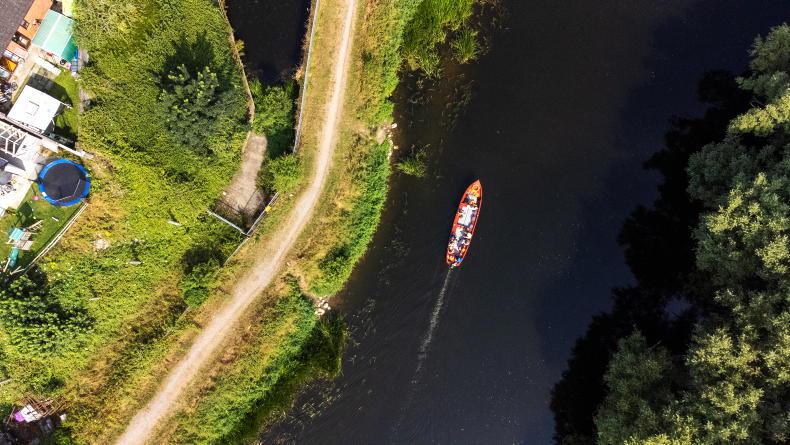
On a sunny day, a boat trip on The Barrow is a great activity to take with your kids. \ Claire Nash
How it works
As you enter the lock, it becomes clear as to why the system is needed. The water level on one side is much higher than the other. As the lock is lifted, water either fills the lock or empties out of it; enabling the boat to safely pass through varying water levels. It’s a clever and ancient system; obviously still used today. Especially with kids on the boat, it’s a fun experience as the water rushes in or out.
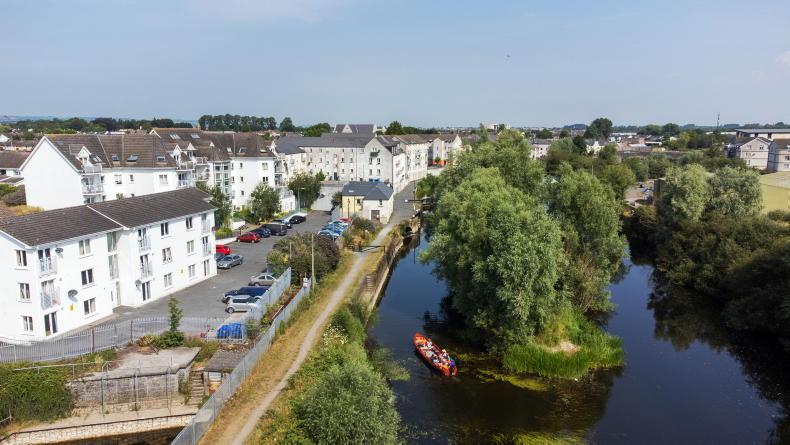
As the boat approaches Carlow town. \ Claire Nash
“The boatmen who worked the canal system were called the Barrow Boys,” Cliff recalls. “They went up and down the river, transporting all kinds of agricultural produce. And the lock keepers wives were essential to keeping the canals working, but never got any recognition for their work.
“Very often, what would happen is a lock keeper took this job because he got a house [with it], but the wages were so poor that many went off and worked for local farmers. They left their wives to operate the locks while they were away, but this was never historically recorded – so the women and children operated the locks. On the Barrow, they were operated during daylight hours, and the boats were constantly moving; bringing barley to Dublin or beets to the local sugar factory.”
Bouncing back
It’s no secret that the COVID-19 pandemic had a disastrous effect on tourism and associated businesses, and Cliff’s business was no exception. However, as restrictions begin to ease and more of the population become vaccinated, he still sees a bright future for himself and Ireland’s rural regions.
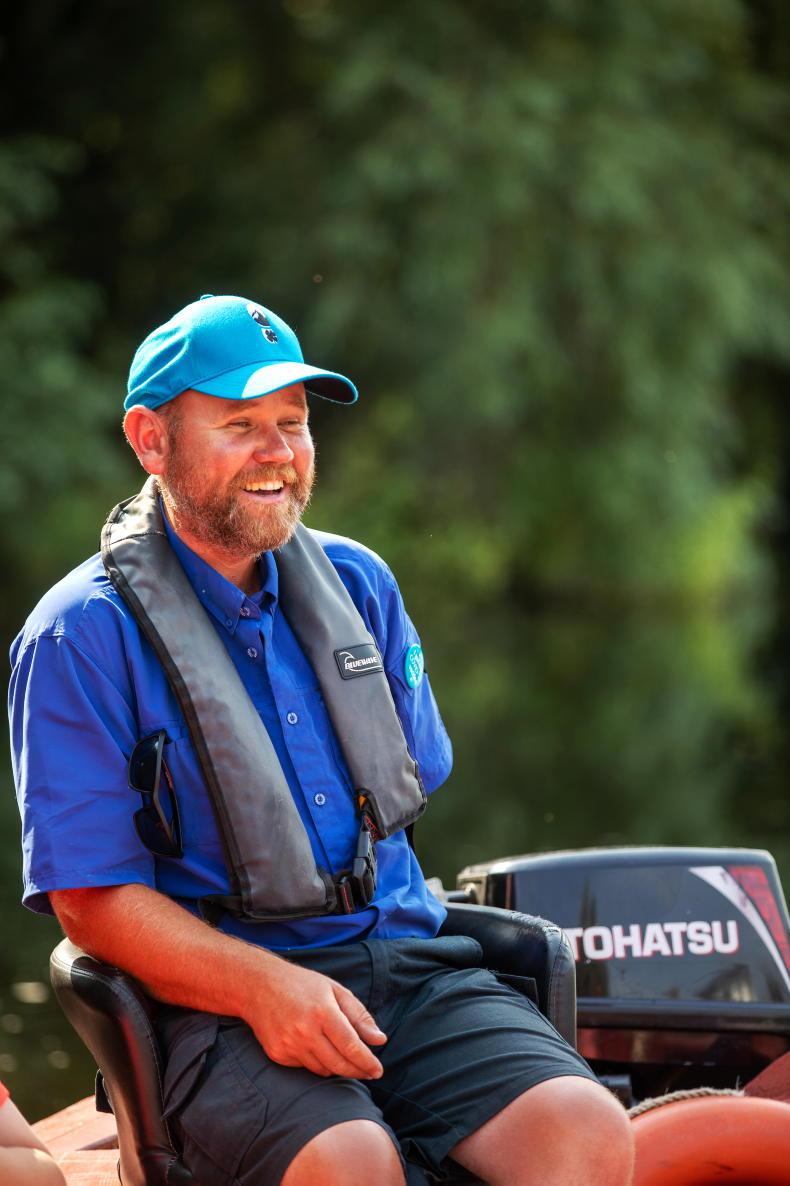
Cliff regales his guests with stories of the Ireland's inland waterways' history. \ Claire Nash
“We went from having 80% international tourists on our boats to 0% overnight,” he says. “Over the last year we needed to revisit our marketing strategies and focus on staycationing – especially this year. But it worked out, in fairness. I get a lot of locals; the Irish have been supportive of small business and to those who are self-employed. This year, I noticed the people who would normally go to Spain or mainland Europe were happy to spend their money here.
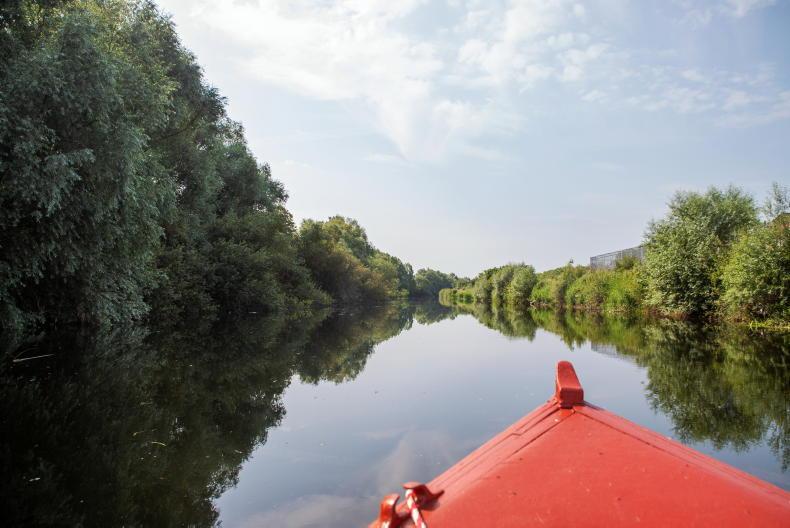
The boat is slow; making for a peaceful and serene experience. \ Claire Nash
“More people are looking to explore Ireland’s midlands and see the less travelled counties (which tend to have a smaller tourist footprint),” he adds. “I’ve seen lots of people coming to visit [Carlow, Kilkenny, Laois and Kildare] from counties like Cork and Kerry. They want a slow, relaxing holiday, and we do that well here.”
“From a very young age, I just fell in love with the river,” Cliff Reid tells me. “I’m 42 now and I’ve spent over 25 years on the river. I still can’t go over a bridge without stopping and looking down into the water.”
We meet Cliff on a hot, sunny morning in Carlow Town Park, on the River Barrow jetty.
Behind him floats the traditional Irish open boat in which he conducts his business, boattrips.ie. Cliff’s approach to providing a safe space to explore and learn about Ireland’s river systems has been a key aspect of his business’s success.

The boat enters the lock near the jetty in Carlow Town Park. \ Claire Nash
Operating out of Carlow, Kilkenny, Laois and Kildare, Cliff offers private river tours for small groups and families. These range from 30 to 80 minutes in length (prices range from €50-100) and incorporate not just the surrounding natural beauty, but the history of Ireland’s inland waterways and their close connection to agriculture and industry.
Born and raised on The Barrow
Irish Country Living asks Cliff what sparked such an interest in rivers to enable him to create an entire career.

We spotted a heron (on the tree) during our trip, as well as a kingfisher. \ Claire Nash
“I was born and raised in Athy, and my house was 100m from the River Barrow,” he explains. “I was swimming, fishing and boating from a very young age. I bought my first boat when I was 16 – I saved up for two years to buy that boat. I spent that summer, then, just working on the boat and being on the water.
“I started fishing,” he continues. “Any day I had off was spent fishing on the river. Then, at 17 or so, I started kayaking – that opened up the river from a different perspective, for me. Lord’s Island (in the Barrow) was like my playground. Any weekend was spent fishing from that island or camping out.

The boat is safe and comfortable; Cliff is prepared for most types of weather. \ Claire Nash
“We’d go down on the weekend, fish, eat whatever we caught – that was the kind of childhood I had. The island itself was formed by the canal (on one side) and the River Barrow (on the other). It had its own little forest and wildlife: otters, kingfishers, mallard ducks, sandpipers.”
Learning as you go
As Cliff found his feet (so to say) in his kayak and on the river, he says he also learned a lot from older people within the locality. The stories and wildlife knowledge he picked up from these people ultimately helped develop his business.
“You’d meet characters on the river and people would tell you stories – I love listening to the old folk on the river,” he smiles. “You’d go off with fishermen – I spent a lot of time fishing down in Carlow with my uncle. You’d learn stuff as you went along, and, on top of that, you’d learn from books. At an early age, I had an interest in birds. Each time you’re out on the river, you’d pick up different bits about nature and – then – when you have an interest you kind of start seeing it everywhere.”
Building a business
Building a business can be a slow and, for some, laborious process. For Cliff, it happened organically and is a testament to what can happen if you let your passions lead the way. He was originally working with the Ploughing Championships (he still helps out as needed), and taking visitors on kayaking tours of the Barrow. He eventually took the plunge (pun intended) and launched boattrips.ie in 2018.
At that time, they had one boat and the draw was mainly to international tourists travelling along the Ireland’s Ancient East trail. This business model worked well, so Cliff bought a second boat and moved into Kilkenny. They now have four boats which service the four counties where they provide tours.

Approaching the lock in Carlow town. \ Claire Nash
“When people come, we aim to provide them with three basic things,” he says. “First and foremost, we want them to be safe, but we also want people to have fun and enjoy themselves. Third, we hope people can go away having learned a little – whether about the wildlife or the history of the area.”
Nature
“It’s a really good day if you see a kingfisher and, sometimes, you’ll see otters,” Cliff addresses the boat as we slowly make our way down the Barrow. “Oh, look! There’s a heron.”

While we amble along, we are conversing with our boatmates: a staycationing family. They are farmers and live nearby, but have never done one of Cliff’s river tours. Their children are excited, as is my own daughter, and Cliff gives them each a chance to “drive the boat”, in turn.
But first, we take a few minutes to appreciate the nature around us – the heron; the many dragonflies skimming the surface. At times, you can see fish darting around in the water and – lo and behold; there it is: the iconic kingfisher. Our trip had been made (unfortunately, he was too quick for our photographer to capture).
“It’s something I notice – when you bring kids out the first thing they do is put their hands in the water – adults don’t do this,” Cliff points out. “We lose our connection with the water as we get older. Years ago, the rivers were the highways of Ireland – that’s where all the towns were established. Access to food and water, a way of getting rid of waste and a mode of transport – the connection people had with rivers [then] was massive.

The boat approaches the lock in Carlow town. \ Claire Nash
“Everyone has their busy lives, but on the boat you’re forced to slow down to the speed of the boat.”
History of a river
On the tour, Cliff teaches us about Ireland’s canal systems. The Guinness factory required barley from farms outside of Dublin, for example. The easiest way to get the grain to the factory? By river and canal, on a boat not dissimilar to the one we’re on.

On a sunny day, a boat trip on The Barrow is a great activity to take with your kids. \ Claire Nash
The extensive lock and canal system along the Barrow (which is the second-longest river in the country and, through its tributaries the Nore and the Suir, has historically connected a vast region of Ireland – from the port of Waterford and the Grand Canal in Dublin) is a masterful piece of engineering and design. We not only learn about this system on our trip – we experience it firsthand as we greet Carlow’s lock keeper, William O’Neill, and he opens it for us.
“There are now four lock keepers on the Barrow; covering 26 locks,” Cliff explains. “At one time, it would have been one lock keeper for each lock. People will normally ring ahead and the keepers will meet them at the lock. They also have several other jobs to do, in terms of managing water levels in the winter and general management and upkeep. They’re employed by Waterways Ireland.”

On a sunny day, a boat trip on The Barrow is a great activity to take with your kids. \ Claire Nash
How it works
As you enter the lock, it becomes clear as to why the system is needed. The water level on one side is much higher than the other. As the lock is lifted, water either fills the lock or empties out of it; enabling the boat to safely pass through varying water levels. It’s a clever and ancient system; obviously still used today. Especially with kids on the boat, it’s a fun experience as the water rushes in or out.

As the boat approaches Carlow town. \ Claire Nash
“The boatmen who worked the canal system were called the Barrow Boys,” Cliff recalls. “They went up and down the river, transporting all kinds of agricultural produce. And the lock keepers wives were essential to keeping the canals working, but never got any recognition for their work.
“Very often, what would happen is a lock keeper took this job because he got a house [with it], but the wages were so poor that many went off and worked for local farmers. They left their wives to operate the locks while they were away, but this was never historically recorded – so the women and children operated the locks. On the Barrow, they were operated during daylight hours, and the boats were constantly moving; bringing barley to Dublin or beets to the local sugar factory.”
Bouncing back
It’s no secret that the COVID-19 pandemic had a disastrous effect on tourism and associated businesses, and Cliff’s business was no exception. However, as restrictions begin to ease and more of the population become vaccinated, he still sees a bright future for himself and Ireland’s rural regions.

Cliff regales his guests with stories of the Ireland's inland waterways' history. \ Claire Nash
“We went from having 80% international tourists on our boats to 0% overnight,” he says. “Over the last year we needed to revisit our marketing strategies and focus on staycationing – especially this year. But it worked out, in fairness. I get a lot of locals; the Irish have been supportive of small business and to those who are self-employed. This year, I noticed the people who would normally go to Spain or mainland Europe were happy to spend their money here.

The boat is slow; making for a peaceful and serene experience. \ Claire Nash
“More people are looking to explore Ireland’s midlands and see the less travelled counties (which tend to have a smaller tourist footprint),” he adds. “I’ve seen lots of people coming to visit [Carlow, Kilkenny, Laois and Kildare] from counties like Cork and Kerry. They want a slow, relaxing holiday, and we do that well here.”
















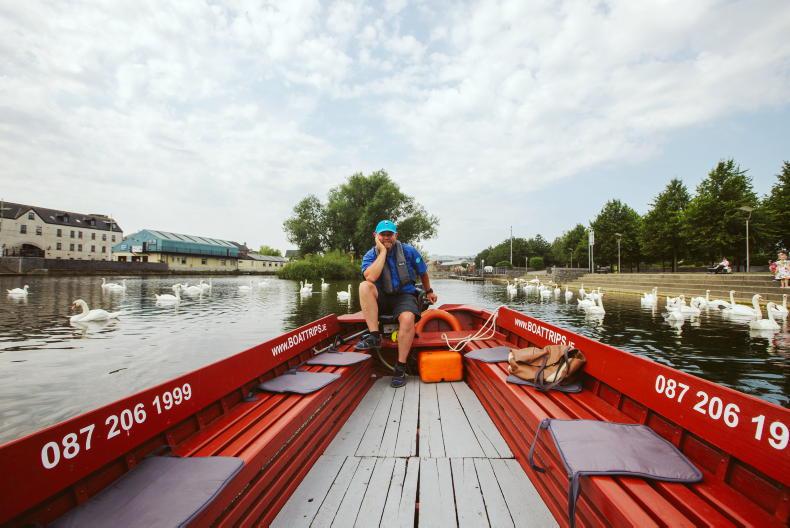
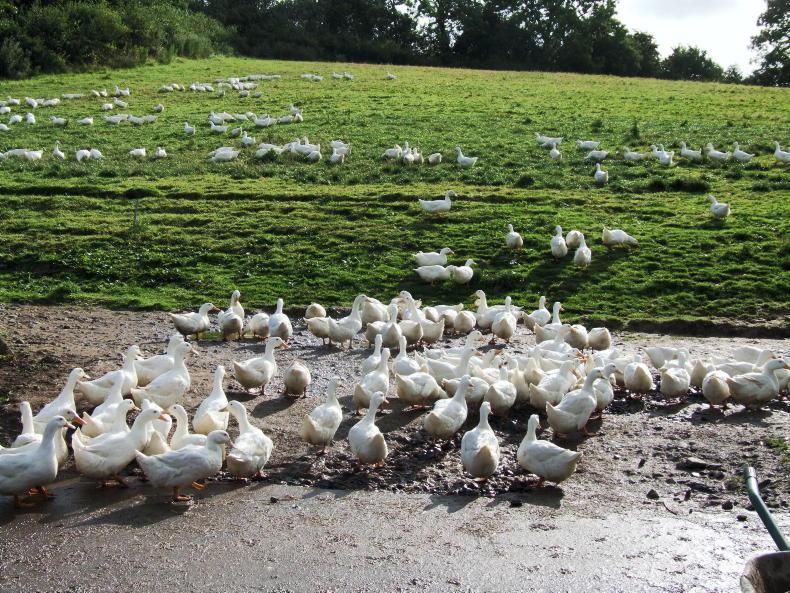

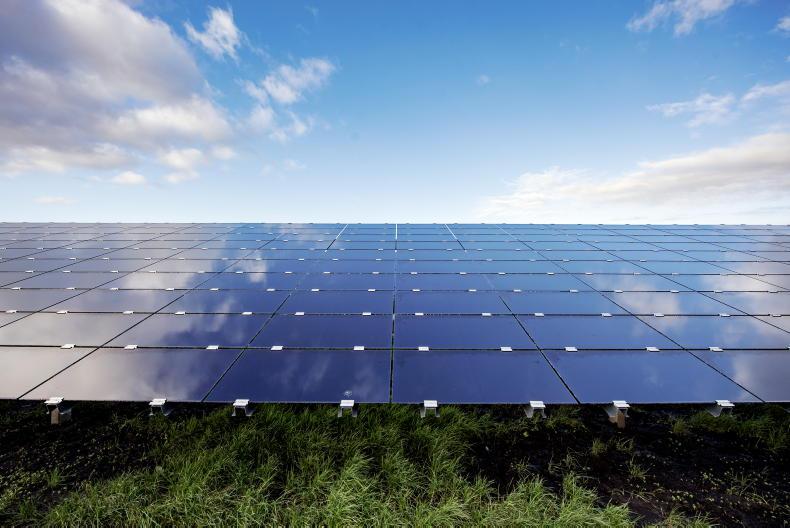
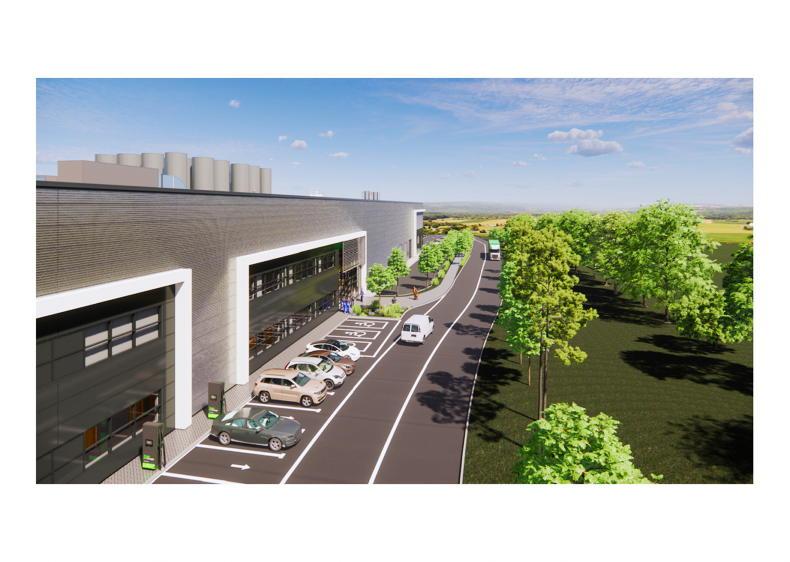
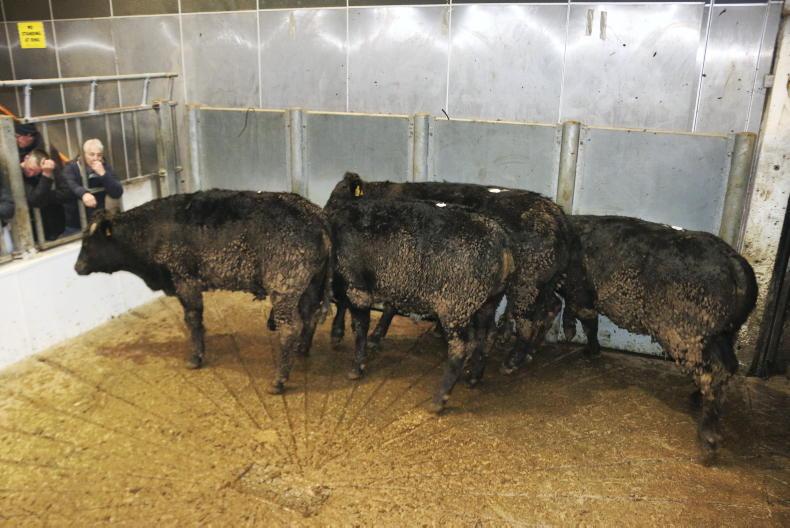
SHARING OPTIONS